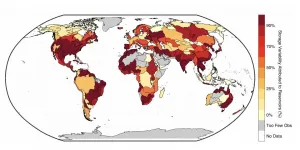Incentives can reduce alcohol use among American Indian and Alaska Native people
2021-03-03
(Press-News.org) SPOKANE, Wash. - The researchers' findings showed that participants who were given A low-cost, easy-to-administer intervention that uses small prizes and other incentives to reward alcohol abstinence can serve as an effective tool to reduce alcohol use among American Indian and Alaska Native communities, new research suggests.
Published today in JAMA Psychiatry, the study tested a culturally adapted version of an intervention known as contingency management in American Indian and Alaska Native adults diagnosed with alcohol dependence, a severe form of alcohol use disorder. The researchers' findings showed that participants who were given incentives to reward alcohol abstinence were 70% more likely to test negative for alcohol use than control participants.
"Contingency management can help people jumpstart their interest in cutting down on their drinking in a way that is positive, helps build their confidence, helps them feel connected, and really acknowledges their journey and their recovery," said study co-author Katherine Hirchak, a descendant of the Eastern Shoshone Tribe and an assistant research professor at the Washington State University Elson S. Floyd College of Medicine. She said the intervention's positive approach fits well with Native values and helps counterbalance the stigma around alcohol use among American Indian and Alaska Native people, a complex issue that defies generalizations.
Designed and conducted in partnership with three Native communities in urban and rural areas in Alaska, the Pacific Northwest, and the Northern Plains, the study is the first multi-site trial to test the use of contingency management to reduce alcohol use among Native adults. It follows on another recent study published by the researchers in the journal Addiction that showed similarly promising results on a single rural reservation in the Northern Plains.
"Together, these two studies provide evidence that this intervention would work across a diverse group of Native communities and could be used as one part of a comprehensive system of addiction treatment to help reduce alcohol-related inequities in Native communities," said lead author Michael McDonell, a professor at Washington State University's Elson S. Floyd College of Medicine. He added that the studies were also two of the largest of this intervention in alcohol use disorder in any population.
As part of the multisite study, the researchers conducted a 12-week trial that included 158 participants recruited across the three sites. Participants were randomized into a contingency management intervention that provided incentives for submitting alcohol-negative urine samples during twice weekly visits, or a control intervention that provided incentives for simply submitting urine samples with no requirement for alcohol abstinence.
Alcohol abstinence was verified through ethyl glucuronide (ETG) testing, which can detect the presence of alcohol in urine for up to three days. Incentives were given through prize draws that had participants drawing tokens that either contained positive phrases, such as "good job," or could be exchanged for prizes that varied in value from $1 up to $80. Prizes included gift cards, culturally significant items such as fishing equipment or beading supplies, and practical items like shampoo and clothing. For participants in the contingency management intervention, the number of prize draws at each visit increased with the length of their abstinence.
The researchers' finding that contingency management participants were 70% more likely to submit an alcohol-negative urine sample is a modest but significant effect that McDonell said is amplified by the intervention's low cost -- with the median total cost of prizes per person being only $50 -- and its potential public health benefit to a large group of people. The intervention can be used with minimal staff training and could be conducted from any location. Recently introduced rapid urine test cups have eliminated the need for expensive urine analyzing equipment that was used in the study, removing one potential barrier to widespread adoption of contingency management.
McDonell said he is already in contact with different tribes and states interested in training communities on how to use this approach. Researchers and employees at Southcentral Foundation -- an Alaska Native-owned nonprofit health care system that served as one of the three study sites -- had the opportunity to observe the intervention's benefits firsthand. Southcentral Foundation's Four Directions Outpatient Treatment Center is looking at incorporating it into its intensive outpatient substance use treatment program.
"Participants told us that their experience of being in the study was life changing," said Jennifer Shaw, senior researcher at Southcentral Foundation and a co-author on the study. "Many said that the impact of the intervention on their self-efficacy and their relationships was incredibly positive, which really affirms the Nuka System of Care, the relationship-based model of health care built by Alaska Native people."
INFORMATION:
Funding for the study came from the National Institute on Alcohol Abuse and Alcoholism.
[Attachments] See images for this press release:

ELSE PRESS RELEASES FROM THIS DATE:
2021-03-03
During the COVID-19 pandemic in 2020, there was a 34% increase in alcohol withdrawal (AW) rates among hospitalized patients at ChristianaCare, according to a research letter published today in the Journal of the American Medical Association.
The study is believed to be the first to quantify the impact of the COVID-19 pandemic on alcohol withdrawal among hospitalized patients.
The retrospective study conducted at ChristianaCare, one of the largest health systems in the mid-Atlantic region, found that the rate of alcohol withdrawal in hospitalized patients was consistently higher in 2020 compared to both 2019 and the average of 2019 and 2018.
"Our findings are relevant nationally and serve as a clarion call to alert ...
2021-03-03
What The Study Did: Whether alcohol withdrawal rates among hospitalized patients with alcohol use disorder increased during the COVID-19 pandemic was examined in this study.
Authors: Ram A. Sharma M.D., of Christiana Care in ,Newark, Delaware, is the corresponding author.
To access the embargoed study: Visit our For The Media website at this link https://media.jamanetwork.com/
(doi:10.1001/jamanetworkopen.2021.0422)
Editor's Note: The article includes conflict of interest and funding/support disclosures. Please see the article for additional information, including other authors, author ...
2021-03-03
What The Study Did: Researchers in this randomized clinical trial examined the effectiveness of incentives offered for laboratory-confirmed abstinence from alcohol among American Indian and Alaska Native adults diagnosed with alcohol dependence.
Authors: Michael G. McDonell, Ph.D., of Washington State University in Spokane, is the corresponding author.
To access the embargoed study: Visit our For The Media website at this link https://media.jamanetwork.com/
(10.1001/jamapsychiatry.2020.4768)
Editor's Note: The article includes conflict of interest and funding and support disclosures. Please see the article for additional ...
2021-03-03
What The Study Did: This study combined the results of 27 studies with 10,000 participants to investigate the association between cardiovascular risk factors such as diabetes and high blood pressure and cognitive impairment in people with schizophrenia.
Authors: Christoph U. Correll, M.D., of the Zucker Hillside Hospital in Glen Oaks, New York, is the corresponding author.
To access the embargoed study: Visit our For The Media website at this link https://media.jamanetwork.com/
(10.1001/jamapsychiatry.2021.0015)
Editor's Note: The article includes conflict of interest ...
2021-03-03
Water levels in the world's ponds, lakes and human-managed reservoirs rise and fall from season to season. But until now, it has been difficult to parse out exactly how much of that variation is caused by humans as opposed to natural cycles.
Analysis of new satellite data published March 3 in Nature shows fully 57 percent of the seasonal variability in Earth's surface water storage now occurs in dammed reservoirs and other water bodies managed by people.
"Humans have a dominant effect on Earth's water cycle," said lead author Sarah Cooley, a postdoctoral scholar ...
2021-03-03
Researchers from Bremen, together with their colleagues from the Max Planck Genome Center in Cologne and the aquatic research institute Eawag from Switzerland, have discovered a unique bacterium that lives inside a unicellular eukaryote and provides it with energy. Unlike mitochondria, this so-called endosymbiont derives energy from the respiration of nitrate, not oxygen. "Such partnership is completely new," says Jana Milucka, the senior author on the Nature. "A symbiosis that is based on respiration and transfer of energy is to this date unprecedented".
In general, among eukaryotes, symbioses ...
2021-03-03
An international research group led by the University of Basel has developed a promising strategy for therapeutic cancer vaccines. Using two different viruses as vehicles, they administered specific tumor components in experiments on mice with cancer in order to stimulate their immune system to attack the tumor. The approach is now being tested in clinical studies.
Making use of the immune system as an ally in the fight against cancer forms the basis of a wide range of modern cancer therapies. One of these is therapeutic cancer vaccination: following diagnosis, specialists set about determining which components of the tumor could function as an identifying feature for the immune system. The patient is then administered ...
2021-03-03
The universe was created by a giant bang; the Big Bang 13.8 billion years ago, and then it started to expand. The expansion is ongoing: it is still being stretched out in all directions like a balloon being inflated.
Physicists agree on this much, but something is wrong. Measuring the expansion rate of the universe in different ways leads to different results.
So, is something wrong with the methods of measurement? Or is something going on in the universe that physicists have not yet discovered and therefore have not taken into account?
It could very well be the latter, according to several physicists, i.a. Martin S. Sloth, Professor of Cosmology at University of Southern Denmark (SDU).
In a new scientific article, he and his SDU ...
2021-03-03
A new software tool allows researchers to quickly query datasets generated from single-cell sequencing. Users can identify which cell types any combination of genes are active in. Published in Nature Methods on 1st March, the open-access 'scfind' software enables swift analysis of multiple datasets containing millions of cells by a wide range of users, on a standard computer.
Processing times for such datasets are just a few seconds, saving time and computing costs. The tool, developed by researchers at the Wellcome Sanger Institute, can be used much like a search engine, as users can input free text as well as gene names.
Techniques to sequence the genetic material from an individual cell have advanced ...
2021-03-03
Information is encoded in data. This is true for most aspects of modern everyday life, but it is also true in most branches of contemporary physics, and extracting useful and meaningful information from very large data sets is a key mission for many physicists.
In statistical mechanics, large data sets are daily business. A classic example is the partition function, a complex mathematical object that describes physical systems at equilibrium. This mathematical object can be seen as made up by many points, each describing a degree of freedom of a physical system, that is, the minimum number of data that can describe all of its properties.
An ...
LAST 30 PRESS RELEASES:
[Press-News.org] Incentives can reduce alcohol use among American Indian and Alaska Native people


